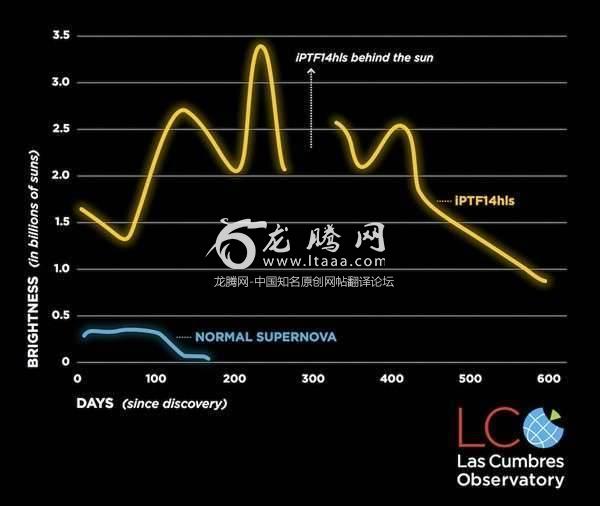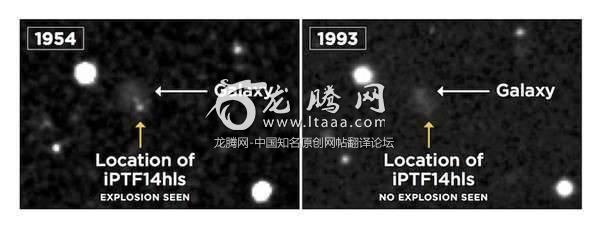天文学家发现曾经在1954年爆发的一颗超新星在2014年再度爆发 [美国媒体]
在这幅由艺术家创作的一颗超新星的概念图中,一层正在扩张的尘埃与气体的外壳正在被向外吹散,从而远离了这颗恒星致密的白矮星内核。大部分的超新星只会爆发一次,从而一劳永逸地结束了它们的生命。然而,iPTF14hls恒星似乎在短短六十年间发生了两次超新星爆发。
Astronomers discovered a star that went supernova in 1954...then again in 2014.
天文学家发现曾经在1954年爆发的一颗超新星在2014年再度爆发
Lead author: "This supernova breaks everything we thought we knew about how they work."
通讯作者称:“这颗超新星打破了我们自认为掌握的关于它们如何运作的一切知识”
In this artist’s concept of a supernova, an expanding shell of dust and gas is blown outward, away from the star’s dense, white-dwarf core. Most supernovae explode just once, which ends their lives for good. However, iPTF14hls appears to have gone supernova twice in just 60 years.
在这幅由艺术家创作的一颗超新星的概念图中,一层正在扩张的尘埃与气体的外壳正在被向外吹散,从而远离了这颗恒星致密的白矮星内核。大部分的超新星只会爆发一次,从而一劳永逸地结束了它们的生命。然而,iPTF14hls恒星似乎在短短六十年间发生了两次超新星爆发。
To quote the first line of a letter published today in the journal Nature, “Every supernova so far observed has been considered to be the terminal explosion of a star.” In other words, when a massive star blows itself up, it should remain dead. This is something astronomers have witnessed thousands of times before with absolutely no exceptions.
这里引用一下今天发表在《自然》期刊上的一篇文章的开头段:“迄今为止观测到的每一次超新星爆发都被认为是一颗恒星的最终爆炸”。换句话说,当一颗大质量的恒星自爆的时候,它应该就死亡了。这是天文学家们之前数千次观测到的现象,绝对没有例外。
That is, until now.
的确如此,直到现在。
For the first time, astronomers have discovered a star that has gone supernova more than once. This so-called “zombie star” — which exploded at least twice in the last 60 years alone — has baffled scientists by challenging many of the existing theories about how massive stars end their lives.
这是天文学家们首次发现一颗两次发生超新星爆炸的恒星。这颗所谓的“僵尸恒星”——单单在在过去六十年里,它就至少爆炸了两次——令科学家们感到迷惑,它挑战了许多已经存在的关于大质量恒星如何结束它们的生命的理论。
“This supernova breaks everything we thought we knew about how they work,” said the study’s lead author Iair Arcavi, a NASA Einstein Postdoctoral Fellow at the University of California-Santa Barbara and Las Cumbres Observatory, in a press release. “It’s the biggest puzzle I’ve encountered in almost a decade of studying stellar explosions.”
这项研究的通讯作者Iair Arcavi ——美国加州大学圣塔芭芭拉分校和拉斯昆布瑞天文台的美国国家航空和宇宙航行局爱因斯坦博士后研究员在一次新闻发布会上说:“这颗超新星打破了我们自认为掌握的关于它们如何运作的一切知识”。
The undying star, named iPTF14hls, was first discovered in September 2014 by the Palomar Transient Factory (PTF), a fully automated, wide-field survey designed to spot cosmic objects that vary in brightness over time — such as variable stars, transient objects, and, of course, supernovae.
这颗没有死亡的恒星被命名为iPTF14hls,它是在2014年9月由帕洛马瞬变望远镜首次发现。帕洛马瞬变望远镜是一种全自动的广域观测望远镜,旨在准确地找到亮度随时间变化的天体——比如变星、瞬变体,当然,还有超新星。
Over the course of two years, iPTF14hls grew and dropped in brightness at least five times. Most supernovae remain bright for around 100 days before fading for good.
在过去两年中,iPTF14hls的亮度增加和减少了至少五次。大部分的超新星会在永远暗淡下来之前保持大约100天的高亮度。
When the international team of astronomers first spotted the explosion, a spectral analysis indicated it was just a run-of-the-mill, Type II-P supernova whose brightness would likely fade after about 100 days. Supernova iPTF14hls, on the other hand, had a different plan.
当一支国际天文学家团队首次发现这次爆发时,光谱分析表明它只是一次普通的爆发,这种II-P型超新星的亮度大约会在100天之后减弱下来。但是iPTF14hls的超新星爆发却有着不同的进程。
Although Supernova iPTF14hls initially faded after its 2014 explosion, within a few months it began to mysteriously grow brighter again. Over the course of three years, iPTF14hls fluctuated between bright and dim at least five separate times.
虽然超新星iPTF14hls在它2014年的爆发之后暗淡了下来,但是在几个月内,它的亮度再度不可思议地增加。在三年的时间里,iPTF14hls的亮度明暗波动至少反复了五次。
“This [was] one of those head-scratcher type of events,” said co-author Peter Nugent, a senior scientist at Lawrence Berkeley National Laboratory. “At first we thought it was completely normal and boring. Then it just kept staying bright, and not changing, for month after month.”
劳伦斯伯克利国家实验室的一名资深科学家,也是这篇文章的合作作者Peter Nugent 说:“这是一种令人费解的现象,一开始我们认为这完全是稀疏平常的。但是它持续保持着亮度,而且没有变化,月复一月都是如此。”
When the astronomers realized iPTF14hls was not an average supernova, they decided to go back and search through archival data. The researchers were flabbergasted when they found that in 1954, another explosion was recorded in the exact same location as iPTF14hls. Somehow, the star survived its first explosion, waited 60 years, and then exploded again.
当天文学家们意识到iPTF14hls不是一颗普通的超新星时,他们决定进行回溯,搜寻归档数据。当研究者们发现在1954年,在iPTF14hls的同一位置发生了另一次的爆炸时,他们大为震惊。这颗恒星以某种方式在第一次爆炸中幸存了下来,在等待了六十年后,再度爆发。
An image taken by the Palomar Observatory Sky Survey reveals a possible explosion in 1954 at the exact location of iPTF14hls (left). It is not seen in the later image taken in 1993 (right).
由帕洛马天文台巡天项目提供的一张照片表明,1954年在iPTF14hls同一位置发生了一次可能的爆炸(左侧照片)。它在1993年的另一张照片中没有被发现(右侧照片)。
Although researchers are still uncertain what caused iPTF14hls to go supernova twice, one theory is that the “zombie star” is actually a “pulsation pair instability supernova.”
虽然研究者们尚不确定什么导致了iPTF14hls发生了两次超新星爆炸,但是一种理论认为“僵尸恒星”事实上是一种“脉动不稳定对超新星”。
“According to this theory, it is possible that this was the result of a star so massive and hot that it generated antimatter in its core,” said co-author Daniel Kasen, a professor of physics and astronomy at the University of California-Berkeley. “That would cause the star to go violently unstable, and undergo repeated bright eruptions over periods of years.” The authors of the study calculated that before the first explosion, the star was at least 50 times as massive as the Sun (and likely larger).
加州大学伯克利分校的物理学和天文学教授,同时也是合作作者之一的Daniel Kasen 说:“按照这一理论,这种现象可能是一颗质量非常巨大、温度非常高的恒星在其核心产生反物质所导致的结果”。这项研究的作者们计算得出,在第一次爆炸之前,这颗恒星的质量至少有太阳的五十倍那么大(可能更大)。
“These explosions were only expected to be seen in the early universe and should be extinct today,” said co-author Andy Howell, leader of the LCO supernova group. “This is like finding a dinosaur still alive today. If you found one, you would question whether it truly was a dinosaur.”
LCO超新星团队的领导者,合作作者之一Andy Howell说:“这种类型的爆炸被认为只会出现在早期的宇宙当中,现在应该已经绝迹。这就像是在今天发现了活着的恐龙。如果你真的发现了一头恐龙,你将会质疑它是否真的是恐龙。”
Using LCO’s global telescope network, which is specifically designed for sustained observations, astronomers will continue to monitor iPTF14hls for changes in brightness over time.
利用LCO的全球望远镜网络——该网络旨在进行持续性观测——天文学家们将能够继续监测iPTF14hls的亮度变化。
“We could not have kept tabs on iPTF14hls for this long and collected data that challenges all existing supernova theories if it weren’t for the global telescope network,” said Arcavi. “I can’t wait to see what we’ll find by continuing to look at the sky in the new ways that such a setup allows.”
Arcavi 说:“如果没有全球望远镜网络,我们无法在这么长的时间里持续关注iPTF14hls并采集能够挑战所有现存超新星理论的数据。我等不及想看到通过这一步所允许的天空持续观测,我们能够发现什么。”
[–]OfficiallyScraunched 2692 points 1 day ago
Stars can get unstable and blow up, and apparently still have more stuff left over to blow up some more.
恒星们会变得不稳定,然后爆炸,显然在一些地方,还有更多的恒星没有爆炸。
[–]-uzo- 2876 points 1 day ago
For those of us who aren't theoretical astrophysicists, how would a massive star create anti-matter as they're proposing?
能给我们中间那些不是理论天文学家的人解释一下一颗大质量的恒星如何像他们所提出的那样产生反物质?
[–]austinsoundguy 439 points 1 day ago
I love how science is like "we were proven wrong and now we are exited about new things to research." Not pointing fingers at anyone, just saying that's a dope way to handle it.
我喜欢看到的科学的模样是“我们被证明是错误的,现在我们都对有新事物可以研究感到很兴奋”。不是特指任何人,只是说这是处理问题的一种好办法。
[–]OateyMcGoatey 32 points 1 day ago
How do we know it was that star specifically vs a star that may have been in the line of sight?
我们如何能够确定这颗恒星就是在我们视线范围内的那一颗呢?
[–]Nick_Red 20 points 1 day ago*
One means for 'sucking up energy' is the creation of neutrinos with every nuclear reaction. These carry off energy from the active core, through the star material, cooling off the insides. So they break the temperature-fusion balance. This is a path for smallish stars to explode, once they have fused the lighter elements near the core, and the heavier nuclei won't fuse anymore. I'd like to know more about this star, especially its mass.
“吸收能量”的一种方式就是每一个原子核发生反应时产生的中微子。它能够从活跃的恒星核心带走能力,穿越恒星物质,从而让恒星内部冷却下来。所以它们打破了温度-核聚变的平衡。这是小型恒星发生爆炸的方式,一旦它们已经让位于恒星核心位置附近的较轻元素发生了核聚变,较重的原子核就不会再发生核聚变。我想知道更多关于这颗恒星的情况,特别是它的质量。
[–]TheRegicide 261 points 1 day ago
What this means to me "For the first time, astronomers have discovered a star that has gone supernova more than once." is that this is possibly the first time we have witnessed a perfectly natural phenomenon, but this time the period was on the human time scale.
“这是天文学家们首次发现一颗两次发生超新星爆炸的恒星”在我看来意思就是这可能是我们首次见证一次完整的自然现象,但这一次它的周期是位于人类的时间尺度内的。
There is now no way to say the other super novas aren't also periodic.
这绝不意味着其他的超新星就不是周期性爆发的。
The fact we declared type 1a as constant has always bothered me, now this bothers me more.
事实上我们已经知道1a型超新星就是持续的,这一问题始终困扰着我,现在我越来越迷惑了。
版权声明
我们致力于传递世界各地老百姓最真实、最直接、最详尽的对中国的看法
【版权与免责声明】如发现内容存在版权问题,烦请提供相关信息发邮件,
我们将及时沟通与处理。本站内容除非来源注明五毛网,否则均为网友转载,涉及言论、版权与本站无关。
本文仅代表作者观点,不代表本站立场。
本文来自网络,如有侵权及时联系本网站。
图文文章RECOMMEND
热门文章HOT NEWS
-
1
Why do most people who have a positive view of China have been to ...
- 2
- 3
- 4
- 5
- 6
- 7
- 8
- 9
- 10
推荐文章HOT NEWS
-
1
Why do most people who have a positive view of China have been to ...
- 2
- 3
- 4
- 5
- 6
- 7
- 8
- 9
- 10













